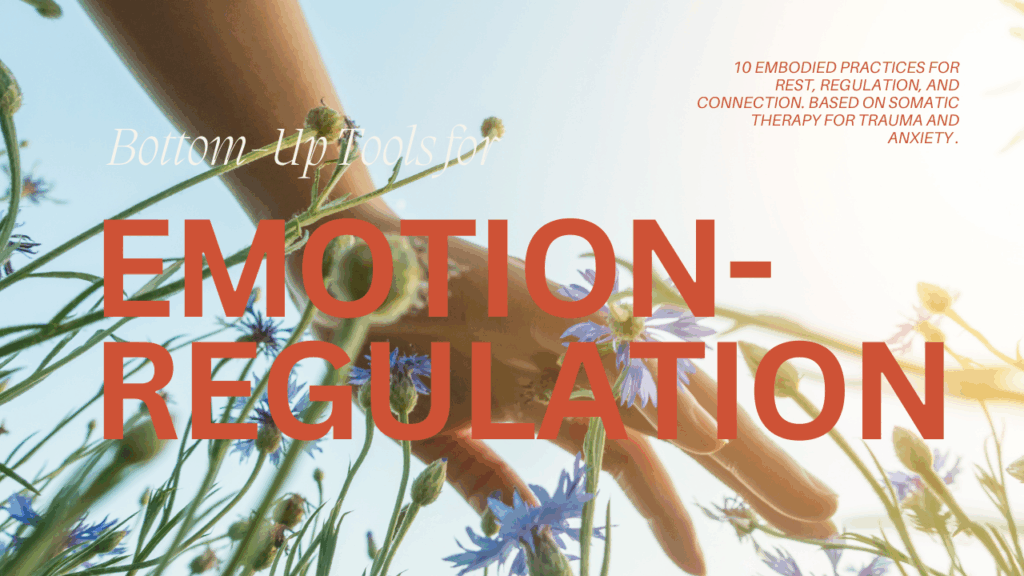
You’ve likely felt this before: the longing to rest, to exhale, to finally let go—yet your body refuses. No matter how safe the space, no matter how much support surrounds you, something inside keeps you on guard.
This is not resistance. This is survival. For many of us, the nervous system has been trained by trauma to live in contradiction: exhausted yet hypervigilant, yearning for rest but unable to lean into it.
Without access to deep physiological rest, it becomes difficult to build the internal safety and regulation that make connection and change possible.
My clients often ask me: “What are some ways we can regulate the nervous system from the bottom up?”
Before we explore, let’s pause on what that means.
- Top-down therapy often starts with the mind—shaping thoughts, beliefs, and narratives.
- Bottom-up therapy, or somatic therapy, begins with the body—its breath, sensations, and movements—to bring safety and presence back online.
Here are ten body-first practices that I return to again and again. They don’t demand perfection. They ask only that you meet yourself where you are, consistently.
Most of these incorporate breath-work, the use of breath and breathing patterns to create positive physiological and emotional changes, such as calming and centering, containment, and affect tolerance.
1) Singing or Humming
Singing increases blood flow to the brain and supports regulation of the heart and nervous system, particularly when performed at a rate of five to six breaths per minute. If done with others, group synchronization increases social cohesion, leading to improved mood and focused attention, while decreasing ruminating thoughts.
- Take a deep breath in and feel your lungs fill with air.
- In unison or independently, exhale as you sing your favorite phrase of music.
- Continue for one to three minutes.
- Notice any shifts in the body.
Humming offers similar benefits, as the vagus nerve passes through the vocal cords. Rhythmic vibrations from humming stimulate the vagus nerve and influence heart rate variability. This helps calm the nervous system with a simple exercise:
- Take a deep breath in and feel your lungs fill with air.
- In unison or independently, hum a familiar tune (don’t worry if you’re off-key).
- Continue for one to three minutes.
- Notice the sensations in your head, throat, and chest.
- Experiment with different volumes and qualities of sound.
- Try Voo Breathing for another variation using sound and vibration.
Feel the resonance spread through your chest and jaw.
2) Orienting
Orientation (connecting to your environment using the senses) allows us to shift attention to the present moment—away from disruptive or repressed thoughts and toward more pleasant bodily sensations and sensory experience.
- Bring attention gently back to your body and environment.
- Feel your feet on the floor.
- Notice the weight of your seat against the chair.
- Look around the room. What colors, shapes, or light do you see? What catches your eye?
- Let your awareness toggle between inside and outside: breath, heartbeat, then sounds, textures, and smells around you.
This pendulating process grounds us in the present.
3) Grounding
Grounding is the sensation of connection with the ground, usually sensed in the feet and legs, with awareness of support from the lower body.
- Lie flat on the floor, or stand up tall on your feet. (If you can’t do this literally, let your imagination lead. Picture yourself lying down or standing tall.)
- Feel the earth hold and support you. Imagine its weight steadying your own.
- If lying down, allow your weight to sink into the ground.
- If standing, gently shift your weight from one leg to the other, swaying slowly like a willow tree.
4) Neck Release
The vagus nerve runs behind the sternocleidomastoid muscle and in front of the scalenes, two of the tightest muscles in the neck, which can irritate the nerve. Gentle stretches can relieve pressure that may compromise vagus nerve function.
- Roll your shoulders up, back, and down, keeping your gaze forward.
- Slowly tip your right ear toward your right shoulder without turning your head.
- Shift your attention to the left side of your neck. When you feel it fully lengthened, bring your gaze to the right and take four to six deep breaths, noticing the sensation on the left side of your neck.
- Return to the starting position and repeat on the left side.
5) Sensory Strategies
The body speaks through sensation. Deep pressure and proprioceptive exercises can regulate the nervous system, increase body awareness, and create a sense of calm.
Our proprioceptive system senses space and detects force and pressure. It helps us locate where we are in space and how to move. Sensory receptors in our muscles and joints are responsible for this sense of proprioception.
- When shut down: Try weighted input such as a blanket or vest to create a sense of security. Squeeze toys can also help ground the body.
- When restless: Engage muscles and joints through 10 jumping jacks, push-ups (on the floor or against the wall), or animal walks like bear crawls.
- When wired-but-tired: Use yoga poses such as Child’s Pose or Downward Dog for grounding pressure, or rub your palms together and place them gently over your eyes for calming input.
- When tense: Gentle but firm pressure through massage can release tension and support relaxation.
6) Self-Soothing Touch
Drawing on Peter Levine’s Somatic Experiencing, gentle self-touch can help the nervous system return to a state of safety and support.
- Place one hand on your heart and the other on your belly.
- Or hug yourself—place your left palm under your right armpit and use your right arm to hold your left arm.
- Try the havening touch—cross your arms over your chest and gently stroke your upper arms, from shoulders down to elbows.
Feel your breath rise and fall beneath your hands. Notice the sense of containment in your body. Feel yourself held.
7) Eye Tension Release
Our eyes are extensions of the brain what Dr. Andrew Huberman calls “exposed neural tissue.” The visual system can therefore be one of the most powerful lever we have to shift our physiological states. Oculocardiac convergence has been shown to reduce anxiety and panic by repeatedly focusing the eyes on a nearby point and then shifting to a distant one. This practice is also called Near-Far Focus or Pencil Push-ups.
- Hold a pencil or small object about 4 to 6 inches in front of your face. Allow your eyes to focus on this object for about 20 to 30 seconds.
- Shift your focus to look off in the distance for about 20 to 30 seconds.
- Continue back and forth for about 4 cycles, then softly relax your eyes.
- Finally, relax your gaze by looking at least 6 feet away. Allow your vision to open wide, perceiving your surroundings as a whole without focusing on any particular object. This is called inviting the Panoramic Vision—a practice that can help deactivate stress mechanisms and promote a deep sense of calm in the nervous system.
8) Crying and Laughing
Both are primal release valves. Let yourself weep. Let yourself laugh. Each helps discharge stress and restore balance.
9) Safe Place Visualization
Research shows that both spending time in nature and guided imagery practices can lower anxiety and support regulation. Nature itself has demonstrated anxiolytic effects, but when access isn’t possible if we’re in indoor or in therapeutic settings, nature-based guided imagery can provide a similar sense of calm.
- Close your eyes if comfortable (or simply soften your gaze, letting your eyes release the tension they hold).
- Visualize a place, real or imagined, where you feel deeply safe, or safe enough. Picture the whisper of autumn leaves. The steady roll of ocean waves. The warmth of sun on your skin.
Pause. Linger. Return as often as you need. - Or find a literal corner—a patch of sunlight, a window breeze, or music that speaks to your heart.
- Pause. Breathe. Stay there as long as you need.
10) Connection
Connection is one of the most powerful regulators of the nervous system. While self-regulation practices can bring relief, sometimes they are not enough on their own. In those moments, co-regulation becomes essential.
- Reach out to someone safe (person or your pet).
- Ask them to sit beside you, to listen, or to hold you.
- Let your body remember, through their presence: You are not alone.
These small moments of connection are bridges from survival into safety, from the grip of trauma into the possibility of presence.

This is the essence of somatic therapy for trauma, anxiety, and stress—teaching the body to rest, to regulate, to trust again.
In Closing
Here’s an additional resource to try: 6 Vagus Nerve Exercises to Boost Well-Being
These small practices can open the door to regulation when words or CBT worksheets alone cannot.
Sources: